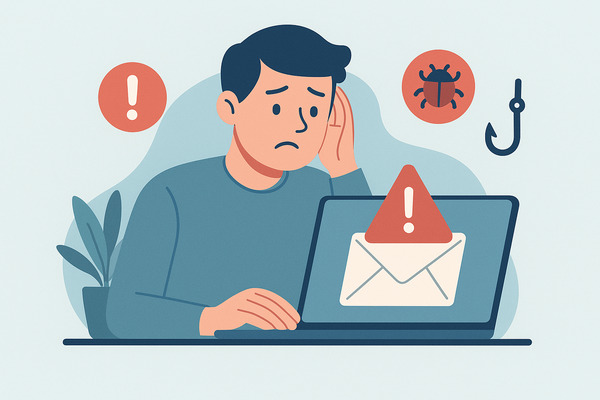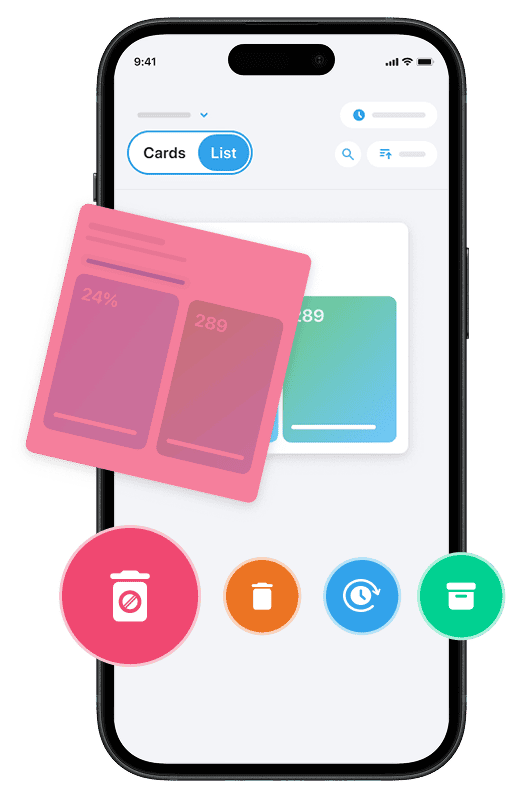Ever wondered what happens if you open a spam email? It’s a common dilemma many of us face daily as we sift through our inboxes.
While opening a spam email might seem harmless, it’s important to understand the potential risks. Simply opening one usually doesn’t cause immediate harm, as long as you avoid interacting with it by clicking on links or downloading attachments. But in some cases, especially with today’s sophisticated attacks, you can actually get hacked just by opening an email. Scammers can still collect some information about you, such as your IP address, location, and device type. This data can be used to launch more targeted phishing attacks in the future. Instead of simply deleting these kinds of messages, it’s much smarter to handle them properly — here’s why you shouldn’t just delete spam emails and what to do instead.
With this information, scammers can refine their strategies, potentially creating more personalized and convincing phishing emails. These emails are designed to trick you into sharing sensitive personal information, which could lead to identity theft or data theft.
One of the best ways to stay free from spammy emails is by using our Cleanfox platform. It helps protect you from unwanted messages and keeps your inbox safe.
The Immediate Effects of Opening a Spam Email
Potential Malware Risks
Opening a spam email itself generally does not automatically install malware on your device unless you interact further by clicking on a suspicious link or downloading an attachment. However, if the spam email contains malicious attachments or links and you open them, you risk exposing your device to malware such as keyloggers, ransomware, or even credential harvesting tools that silently steal your logins.
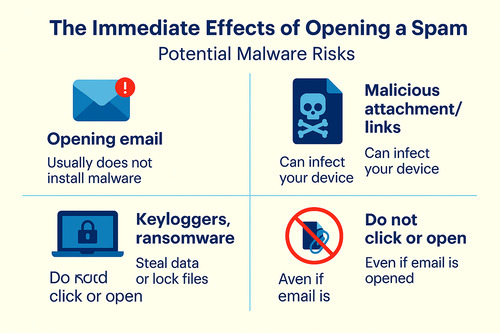
These types of malware can record your keystrokes, steal sensitive data, or lock your files until a ransom is paid. That’s why it’s critical not to open any attachments or click on any links in a spam or phishing email, even if you have already opened the email itself.
The Risk of Address Confirmation
Simply opening a spam email can sometimes alert scammers that your email address is active. When this happens, your email address may be confirmed as valid, increasing the likelihood that you’ll receive more spam or phishing emails in the future.
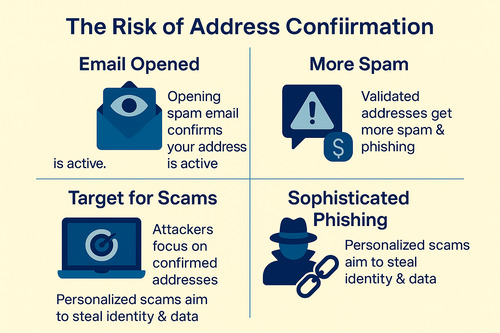
Scammers often use this tactic to verify their targets and hone in on which email addresses are worth attacking further. This process of address confirmation can also put you on the attacker’s radar for more sophisticated scams, including personalized phishing attempts designed to steal your identity or personal data.
Tracking Pixels and Privacy Concerns
Many spam and phishing emails contain hidden tracking pixels—tiny, invisible images that automatically load when you open the email. These pixels can notify the sender that their email has been opened and provide information about your device, location, and email client.
This data helps attackers customize future spam emails or phishing campaigns targeted specifically at you, thereby increasing the risk of identity theft or data breaches. Some email clients disable automatic image loading to help prevent this kind of tracking, but many do not by default, placing your privacy at risk when you open such emails.
What to Do Immediately After Opening a Spam Email
Do Not Click Any Links or Download Attachments
After opening a spam email, it’s important to avoid any further interaction with it. Do not click on any links or download attachments, as these actions can lead to the installation of malware like ransomware or spyware. These malicious programs can compromise your personal data and even allow scammers to take control of your device.
If you suspect that you accidentally clicked on something, immediately disconnect from the internet and take steps to secure your device.
Mark as Spam and Delete
Once you recognize an email as spam or phishing, mark it as spam in your email client. This action helps your email provider improve its spam detection capabilities and reduces the likelihood of similar emails reaching your inbox in the future.
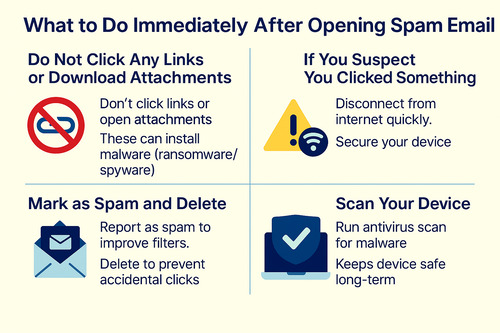
After marking it as spam, delete the email to avoid any accidental interaction with it. This simple step can help prevent further risks associated with the email.
Scan Your Device
Even if you didn’t click on any links or download attachments, it’s still important to scan your device for malware. Use a reliable antivirus program with anti-malware capabilities to check for any viruses or unwanted software. This step ensures that your device is secure and that any potential threats are identified and removed.
Performing regular scans also helps maintain your device’s safety and integrity over time.
Long-Term Protection Against Spam Emails
Say goodbye to spam, clutter, and chaos.
Our smart email cleaner filters out junk, organizes your inbox, and helps you focus on what really matters.
✅ Block spam automatically
✅ Organize emails by priority
✅ Keep your inbox clean
✅ Clean old emails you don’t read
📱 Available on the App Store and Google Play.
Adjust Your Email Settings
One of the most effective ways to protect yourself is by following proven email security best practices, such as adjusting your spam filters and disabling automatic image loading. This includes enabling strict spam filtering, disabling automatic image loading, and setting up a system to explicitly allowlist trusted senders. Allowlisting ensures that emails from trusted sources always reach your inbox, reducing the chances of missing important communications.
Additionally, consider configuring your email client to display images only from trusted sources. This step can help prevent tracking pixels from loading and reduce your visibility to scammers. If you want to stop spam directly on your Apple device, check out this practical guide on how to stop spam mail on iPhone — it walks you through each step to block junk messages and keep your inbox safe.
Educate Yourself About Phishing Tactics
Staying informed about the latest phishing tactics is essential for long-term protection. Educate yourself on common phishing techniques, such as urgency-based scams, personalization, and social engineering ploys designed to trick you into divulging sensitive personal data.
By recognizing these tactics, you can better distinguish between legitimate and malicious emails, reducing the likelihood of falling victim to identity theft or data breaches. Keeping up with the latest cybersecurity news and best practices also helps you stay ahead of emerging threats.
Use Email Security Tools
Utilizing advanced email security tools can significantly enhance your protection against spam and phishing emails. These tools often include features like signature-based malware scanning and URL protection that analyze and block malicious content before it reaches your inbox.
Additional tools may offer real-time threat detection and layered defense strategies to neutralize threats before they cause harm. By integrating these tools into your email security setup, you can ensure robust protection against evolving email-borne threats.
Conclusion
Opening a spam email can expose you to serious risks such as privacy invasion, malware infections, and identity theft. To protect yourself, never click on links or download attachments from suspicious emails.
Always mark spam as such and delete it promptly. Strengthen your defenses by using spam filters, adjusting your email settings to block automatic image loading, and educating yourself on phishing tactics. Incorporating reputable email security tools and staying vigilant will help safeguard your personal data, protect against email account takeover, and maintain your digital security.
Taking these proactive steps is essential for effective long-term protection against spam and phishing threats. For a practical example, see our full guide on How to Stop Norton Spam Emails Quickly and Safely.
FAQ
What immediate risks should I be aware of after opening a spam email?
Opening a spam email itself is usually not immediately harmful, but it confirms your email is active, which can increase targeted phishing risks. The biggest dangers arise from clicking links, downloading attachments, or replying, as these actions may install malware or steal data. Immediate precautions include: not interacting with the email, marking it as spam, deleting it, running a security scan, and monitoring your accounts for suspicious activity.
Can simply opening a spam email infect my device with malware?
Simply opening a spam email does not infect your device with malware. Infection typically requires interacting with malicious attachments, clicking harmful links, or enabling embedded scripts.
Modern email clients are designed to prevent automatic execution of dangerous code upon opening. To stay safe, always avoid opening attachments or clicking links in spam emails.
How do scammers use the information they gather when you open spam emails?
Scammers use information gathered from opened spam emails to confirm active email addresses. They can then personalize future phishing attacks and create targeted scams mimicking trusted entities. Using the personal data they obtain, scammers may steal credentials, financial details, or trick victims into transferring money or installing malware, often leveraging social engineering tactics.
What steps should I take if I accidentally open a spam email?
If you accidentally open a spam email, avoid clicking links, downloading attachments, or replying. Mark the email as spam to help your provider filter similar messages in the future.
Run a malware scan on your device and update your software for added security. If you downloaded an attachment, disconnect from the internet, run a full scan, and change your important passwords to ensure safety.
And this was our article on What Happens If You Open a Spam Email. For more tips and information, visit our blog to learn how to improve your email security.


